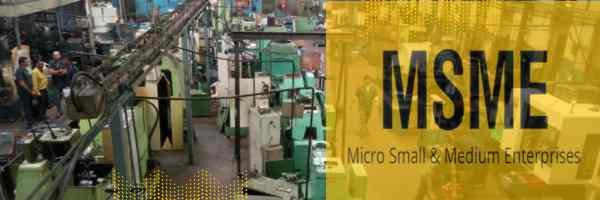Micro Small & Medium Enterprises
Micro Small & Medium Enterprises form the backbone of India’s economy, contributing significantly to employment and industrial growth. Within the SME sector, Micro, Small & Medium Enterprises (MSMEs) are essential components that fuel innovation and provide opportunities for entrepreneurs. In this blog post, we will explore the various initiatives and recommendations put forth by the Reserve Bank of India (RBI) and the Indian government to support the growth of MSEs. These initiatives aim to streamline credit flow, simplify procedures, and encourage the development of this vital sector.
Part 1: RBI Initiatives on Micro Small & Medium Enterprises
The Reserve Bank of India has been at the forefront of facilitating financial support for MSEs through various committees and recommendations for Micro Small & Medium Enterprises.
- Kapur Committee: In 1998, the RBI appointed the Kapur Committee to improve the delivery system and simplify procedures for credit to the SSI sector (now MSE). The committee’s recommendations included delegating more powers to branch managers, simplifying application forms, and enhancing the limit for composite loans. Banks were advised to implement these recommendations, leading to more streamlined and accessible credit for Micro, Small & Medium Enterprises.
- Nayak Committee: In 1991, the RBI constituted the Nayak Committee to examine the credit issues faced by MSEs. The committee recommended giving preference to different categories of small-scale enterprises, standardizing loan application forms, and providing training to bank staff to bring about attitudinal change. Banks were instructed to implement these recommendations, emphasizing the importance of timely and adequate credit flow to the MSE sector.
- Ganguly Committee: In 2003-2004, the RBI formed a Working Group on Flow of Credit to the SSI sector, chaired by Dr. A. S. Ganguly. The committee made recommendations including adopting a cluster-based approach, promoting successful working models of NGOs, and exploring new instruments for promoting rural industries. Several recommendations were accepted and communicated to banks for implementation.
- Rehabilitation of Sick Micro Small & Medium Enterprises: In 2009, the RBI advised commercial banks to establish loan policies governing the extension of credit facilities, restructuring, and rehabilitation of potentially viable sick units in the MSE sector. This step aimed to assist struggling MSEs in reviving their businesses and managing non-performing loans.
- Review of the Credit Guarantee Scheme: A Working Group was constituted to review the Credit Guarantee Scheme for Micro and Small Enterprises (CGTMSE). Recommendations included doubling the limit for collateral-free loans to Micro, Small & Medium Enterprises and encouraging banks to avail of the CGTMSE cover. Banks were advised to follow these recommendations, making it easier for Micro, Small & Medium Enterprises to access credit without collateral security.
Part 2: Government Initiatives on Micro Small & Medium Enterprises
Apart from RBI recommendations, the Indian government has also been proactive in addressing the needs of Micro, Small & Medium Enterprises.
- Prime Minister’s Task Force on Micro Small & Medium Enterprises: In 2010, a High-Level Task Force was established to consider issues raised by Micro, Small, and Medium Enterprises (MSMEs). The task force recommended measures related to credit, marketing, labor, infrastructure, and more. Banks were advised to implement these recommendations, particularly focusing on micro-enterprises.
- Ministry of Small Scale Industries Notification: In 2006, the Ministry of Small Scale Industries issued a notification specifying items whose costs should be excluded when calculating the investment in plant and machinery for MSEs. This notification aimed to provide more clarity and flexibility to MSEs when assessing their investments.
Part 3: Impact and Future Prospects of Micro Small & Medium Enterprises
The combined efforts of the RBI and the Indian government have had a significant impact on the MSME sector. The simplified procedures, increased credit availability, and streamlined policies have created a more favorable environment for MSEs to thrive. The credit flow to this sector has improved, enabling MSEs to grow, create jobs, and contribute to India’s economic development.
The future prospects for MSEs in India are promising, as these initiatives continue to evolve. The ongoing support from the RBI and the government ensures that MSEs will have the necessary tools to withstand challenges and seize opportunities. This support includes a focus on financial inclusion, rural industry development, and improvements in the credit guarantee scheme.
Moreover, the emphasis on digitalization and technology adoption will further enhance the MSE sector’s competitiveness and efficiency. With access to digital payment systems and e-commerce platforms, MSEs can expand their reach and scale their businesses. Additionally, the government’s “Make in India” campaign and initiatives like “Startup India” are fostering entrepreneurship and innovation. These programs encourage the growth of new MSEs and startups by providing financial support, incubation facilities, and mentorship.
Conclusion

Micro and Small Enterprises are the lifeblood of India’s economy, and it’s heartening to see the concerted efforts made by the Reserve Bank of India and the Indian government to support their growth. The recommendations and initiatives discussed in this blog post have undoubtedly made it easier for MSEs to access credit, streamline operations, and thrive in a competitive market.
As these initiatives continue to evolve, and with the advent of digital technology, we can expect to see a flourishing MSE sector that drives economic growth, innovation, and employment opportunities across the country. This, in turn, will contribute to India’s overall economic prosperity and development. Small businesses truly are the backbone of a thriving economy, and India is taking the right steps to ensure their success.
Read also:
Stand-Up India Program : Empowering Entrepreneurs Through Accessible Loans
Elevating Poultry Farming in Bihar: The Poultry Prosperity Initiative
